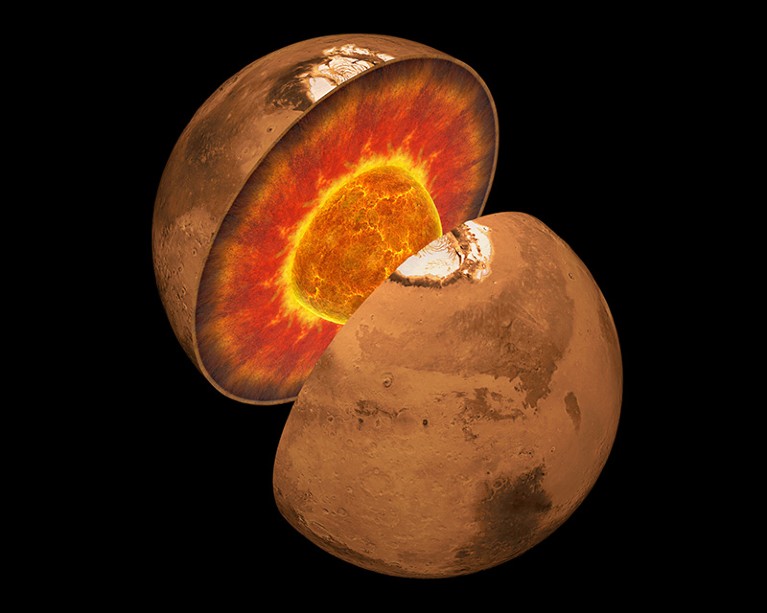Hello Nature readers, would you like to get this Briefing in your inbox free every day? Sign up here.
Mars’s liquid-metal core seems to be smaller than previous studies suggested (artist’s impression).Credit: Claus Lunau/Science Photo Library
Mars contains surprise layer of molten rock
In the interior of Mars, a layer of molten rock envelops the liquid-metal core, which is smaller than previously thought. Scientists discovered the unique layer by analysing the seismic energy that vibrated through the planet after a meteorite impact. The seismic waves’ speed depends on the types of material that they are travelling through. The molten-rock layer might be left over from a magma ocean that once covered the planet.
Nature | 5 min read
References: Nature paper 1 & paper 2
Editor fired after Israel–Hamas remarks
The prominent open-access science journal eLife has fired its editor-in-chief, Michael Eisen, after he retweeted a satirical article referencing the Israel–Hamas war. The board of directors “clearly view this as me having done one too many somethings”, Eisen says. eLife’s board issued a statement indicating that the biologist had been dismissed more broadly because of his approach to leadership, communication and social media. The decision has spurred an exodus of eLife editors, and a protest letter in support of Eisen has so far been signed by more than 2,000 people.
Nature | 6 min read
AI has human-like language ability
An artificial intelligence (AI) system mimics the human ability to quickly fold new words into an existing vocabulary and use them in fresh contexts. By being programmed to learn from its mistakes, the neural network outperformed the chatbot ChatGPT at making generalizations about language, scoring as well as — and sometimes even better than — human volunteers. This suggests that there are ways to reduce the gargantuan amount of necessary training data and make systems more efficient learners, says AI researcher Elia Bruni.
Nature | 5 min read
Reference: Nature paper
Features & opinion
How two spacecraft rewrite solar science
Two solar probes launched in 2018 and 2020 are giving scientists the most detailed views ever of the Sun. The two missions sometimes work together to capture events such as one of the largest solar eruptions ever recorded. “The amount of details, the amount of complexity and also the violence of the event — we’ve never seen it before and it’s just impressive,” says solar physicist Nour Raouafi. The observations can help space-weather forecasters to better understand solar storms, which can disrupt communications and knock out power grids once they reach Earth.
Nature | 8 min read
Academia can’t risk losing postdocs
Postdocs in some parts of the world are striking to highlight their struggles, such as low pay, job insecurity and worries about career progression. Some funders and employers around the world are taking steps to improve the postdoc experience. Others must follow, argues a Nature editorial, or risk losing the next generation of scientists.
Nature | 5 min read
A leader in sustainable development
Gordon Conway (1938–2023) was passionate about agriculture and sustainability long before they were fashionable topics. By paying close attention to local farming practices, Conway revolutionized rural-development approaches. “I remember Gordon and Robert [Chambers, a development scholar] returning from a visit to Wollo in northern Ethiopia in 1988, full of excitement about the lessons they had learnt from farmers,” writes researcher Ian Scoones about his former supervisor.
Nature | 5 min read
